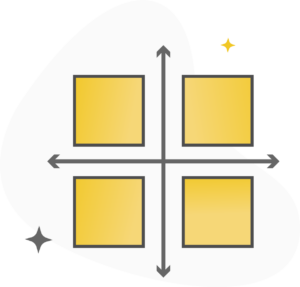When it comes to marketing, communicating with customers is one of the essential steps. Now, you must be having a question how do we communicate with our customers effectively? To answer this question, let us focus on Bull's Eye Framework in this section.
Communicating with customers and understanding their requirements is often termed targeting. Understanding the targeting process will help you identify how companies plan their communication strategies.
You can use the Bulls' Eye Framework to prioritise communication channels to help a brand have maximum outreach. Now the question is, how do you make a Bull's eye framework.
What is Bull's eye Framework?
Let's consider you are developing a brand, and you have to select the channels for its promotions. The Bull's eye Framework will be your go-to solution.
This framework will enable you to brainstorm about all the possible choices and gradually select the most effective ones. In simple words, Bull's eye framework identify the most effective channels that will help a brand grow.
As a student, you will find Bull's eye framework very useful if you want to analyse any brand's promotion strategy or campaign. This will also help you in approaching marketing cases related to promotions and customer outreach.
Developed by Gabriel Weinberg and Justine Mares, the Bull's eye framework list all the marketing channels and categorises them into 3 categories, as shown in the picture below.

What's Possible?
This is the phase where you have to brainstorm and list all the possible marketing channels strategies for promoting any product in the market. The idea is to have a comprehensive list of all the marketing channels
What's Probable?
This phase is more about experimenting and developing strategies for each channel mentioned in the first phase. The strategies developed in this phase are then put to the test to understand how effective they are in delivering the message of the particular product or brand.
What's Working?
This phase denotes by the inner-most ring and is often known as Bull's eye as it helps to develop your plan of action for promotions. The third phase enables you to identify the marketing strategies that have actually worked in the second phase and then zero down on these strategies as a final communication plan.
Example of Bull's Eye Framework
Let us understand with the help of an example.
Consider you work for a B2B service company, and you have to increase its outreach. Let us look at the picture below, where all the 19 channels have been listed in the outer ring while the inner-most circle has narrowed the three marketing channels that would be most effective for the brand.

Source: https://productled.com
How do you make a bull's eye framework?
To make a bull's eye analysis of the marketing campaign of any brand or product, you have to follow the five-step process as shown in the picture below.

Stages of Bull's Eye Framework
Brainstorming
The first and foremost step for Bull's eye analysis is listing down the strategies that can be used for all the possible marketing channels. During this brainstorming phase, you must consider the channels that are typically successful for similar brands in a similar environment.
You can also understand this as a step where we make a list of "What's possible?", i.e., the outermost circle of the Bull's eye Framework.
Ranking
Next, you organise the ideas and strategies you brainstormed in the previous step by assigning a rank. In this step, you require to think critically about the strategies in terms of their feasibility and effectiveness. These rankings will help you select only the probable options and eliminate the rest of them in the next step.
Prioritising
After ranking, this step will enable you to determine the strategies to place in the mid-circle of the Bull's eye Framework. You have to prioritise the strategies according to the ranks assigned in the previous step.
Testing
Once identified all the probable effective strategies, you have to test these strategies in the real world for evaluating whether a particular strategy is fit or not for a specific brand. This step will help you identify the strategies that would fit in the inner-most circle of the Bull's eye framework.
During testing, you need to look after the factors like whether you can reach desired customers through this channel. This will answer the following questions:
- How many customers you can approach through each channel?
- How much resources are invested for each of these channels?
Focusing
After testing, you select the most effective strategies for the inner-most circle of the Bull's eye Framework. In this step, you have to focus on these strategies for executing the promotions of your product or brand.
What is the step ahead?
You have now developed a fair understanding of customers' behaviour in the previous chapter. You have also understood how to devise promotion strategies systematically for any particular product in this chapter. As a budding market professional, the next step is to understand how you should place your product to communicate a clear message to your target market. In the next chapter, I will focus on the product positioning to be equipped to carry out the STP for any product or brand after going through these chapters.

